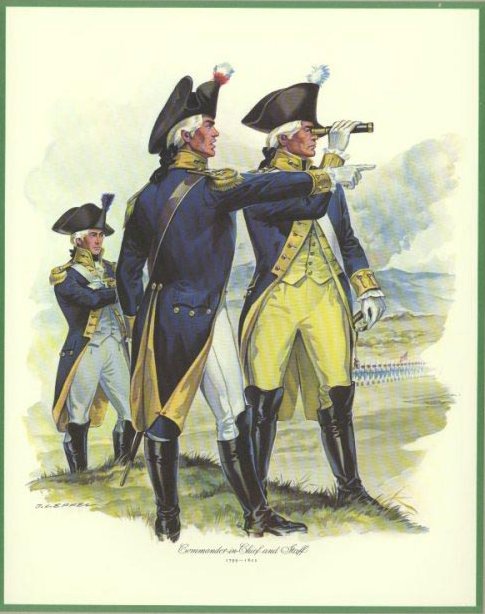![[Ealge with Flag]](eagle1.gif)
| UNIFORMS
OF
THE AMERICAN REVOLUTION In July, 1775 when General George Washington arrived at Cambridge to take command of the Continental Army, he found a force of some 16,000 men scattered over ten miles of lines. Washington organized the army into three divisions of two brigades each. Artemas Ward was given the command of the division at Roxbury, Charles Lee the division at Prospect Hill and Israel Putnam the division at Cambridge. Each of the brigades were divided into six regiments. To further develop the organization of the troops Washington ordered that Major-Generals were to wear purple ribbon across their breasts; Brigadier-Generals were to wear pink ribbons; Aides were to wear green ribbons. Washington, as Commander-in-Chief, wore a light blue ribbon. In June, 1780, epaulettes were prescribed for the officers as follows: Major-Generals, two epaulettes each with two stars; Brigadier-Generals, two epaulettes each with one star; Colonel, two plain epaulettes; Lieutenant-Colonels and Majors, the same as for Colonels; Captain, one epaulette on the right shoulder; and for the Subalterns, one epaulette on the left shoulder. Our illustration shows the dress for General officers in 1799 wearing epaulettes adopted by the War Office in January, 1799. The regulations were very similar to that of 1780 but specified that Generals would wear gold epaulettes with silver stars in the number prescribed above. No change was made in the Colonel's epaulettes. Majors were to wear an epaulette on the right shoulder and a strap on the left shoulder. No change was made for Captains and Lieutenants. The blue faced buff was still the same as specified during the American Revolution. [REFERENCES: The War of the Revolution. Christopher L. Ward. "Military Collector and Historian". Vol. II, No. 2, June, 1950.] |
| Commander-in-Chief
and Staff
1799-1802
|
|
More Uniforms of the American Revolution | Next Page | Uniforms Index | Return to Main Menu eMail the WebmasterCopyright
Notice
|
